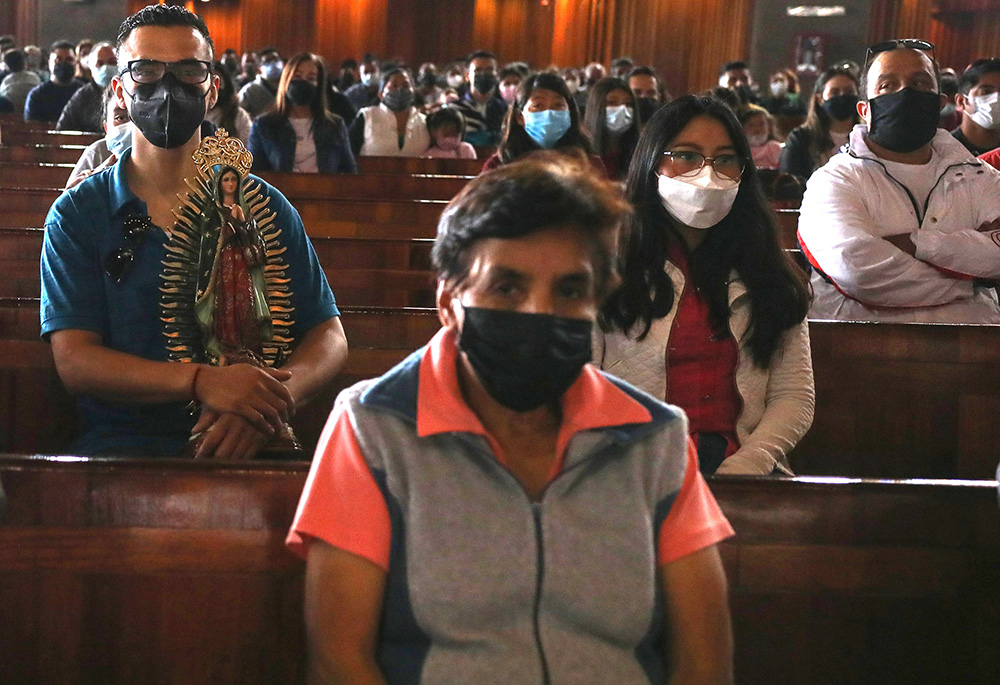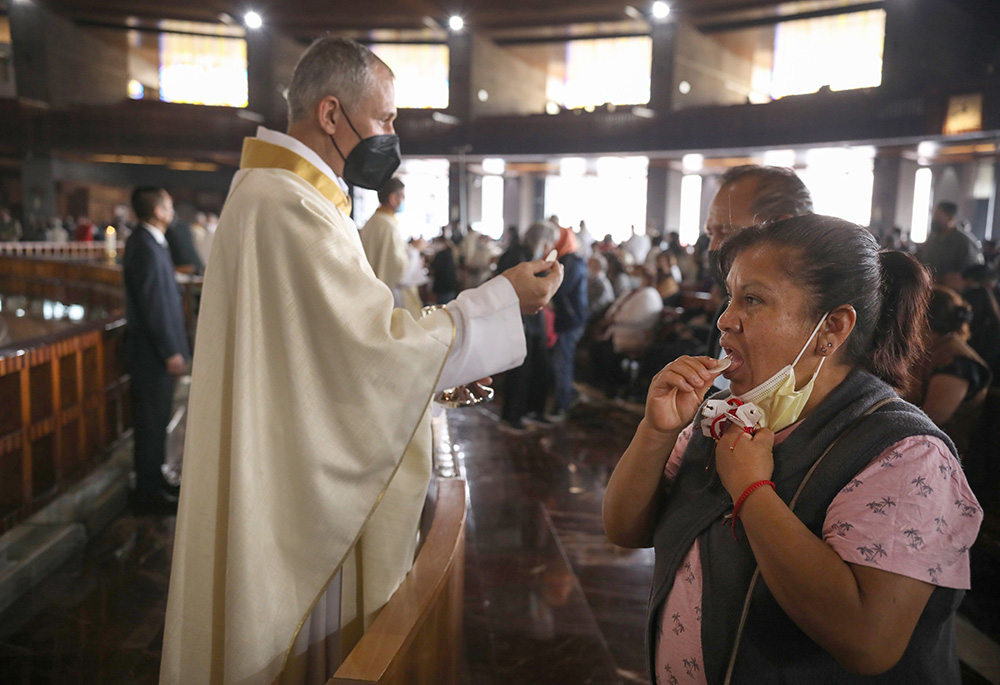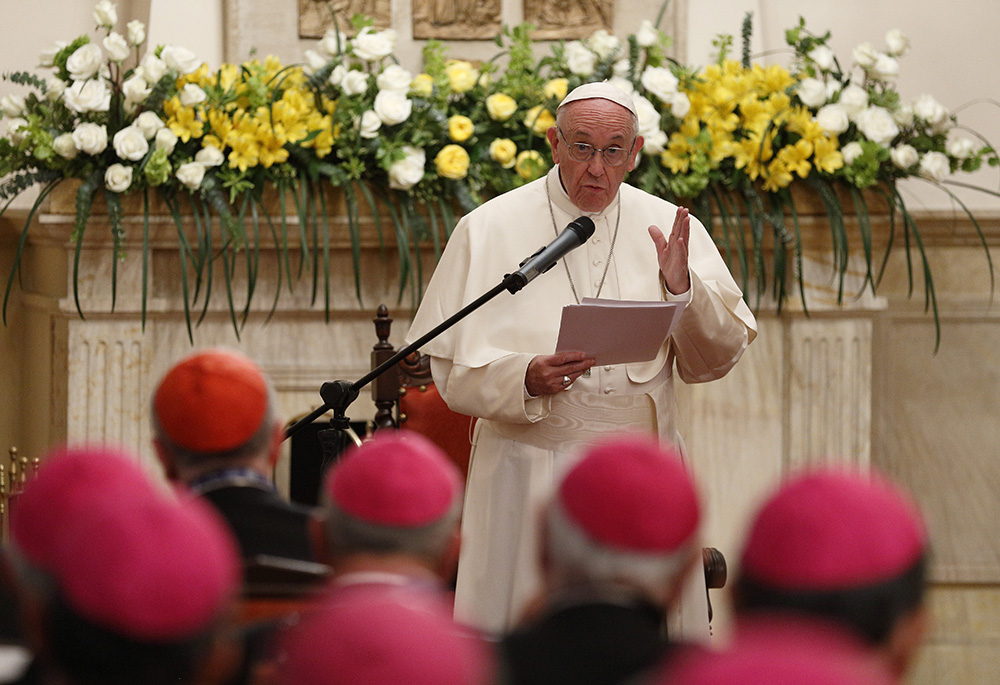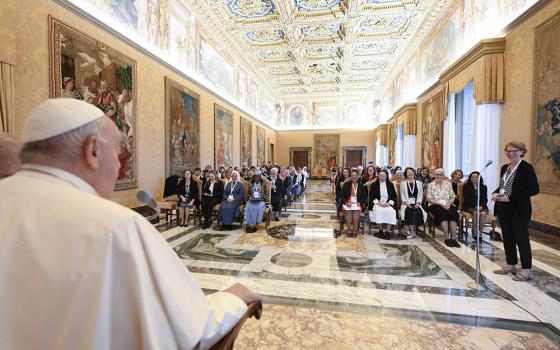
A man holds a statue of Our Lady of Guadalupe during Mass at the opening of the Sixth Ecclesial Assembly of Latin America and the Caribbean at the Basilica of Our Lady of Guadalupe Nov. 21, 2021, in Mexico City. (CNS/Emilio Espejel)
Editor's note: The following keynote address was delivered at a conference for and with a group of U.S. bishops March 25-26 in Chicago. "Pope Francis, Vatican II, and the Way Forward" was co-organized by Loyola University Chicago's Hank Center for the Catholic Intellectual Heritage, Boston College's Boisi Center for Religion and American Public Life, and Fordham University's Center on Religion and Culture. Also helping with the organization was NCR political columnist Michael Sean Winters.
NCR presents this commentary by Archbishop Hector Miguel Cabrejos Vidarte in English. The Spanish version is here.
NCR presenta este comentario de Archbishop Hector Miguel Cabrejos Vidarte en inglés. La versión en español está aquí.
As president of CELAM, I am grateful to Loyola University of Chicago, for holding this important international conference on "Pope Francis, Vatican II, and the Way Forward" in the perspective of ecclesial renewal in a synodal context. I congratulate the organizers of this valuable initiative. At the same time, I appreciate the invitation to address you.
I wish to share this reflection on the deepening of ecclesiality in a synodal framework, which has been clearly marking the path (camino) of the church in Latin America and the Caribbean and to which CELAM is firmly committed.
The General Assembly of CELAM in Tegucigalpa (2019), during which I had the privilege of having been elected president of CELAM by my brothers in the episcopate, set forth the guidelines to initiate a deep and serious process of renewal and pastoral and institutional restructuring of CELAM. Among the many guidelines, we have identified those oriented with a greater intentionality in changing the pastoral style to one that is more collaborative as part of the gradual construction of a synodal ecclesial culture, as Pope Francis asks us and shows us by example. The most significant mandates were:
- To stop along the way to conduct a serious analysis and discernment on the pastoral mission of CELAM;
- To encourage CELAM to be a synodality school;
- To restructure in order to respond with greater competence to the pastoral reality that we encounter;
- To devise other more adequate pastoral structures.
This mandate emanates from the renewing force that the Second Vatican Council has given us. The conciliar decree Unitatis Redintegratio, of Nov. 21, 1964, clearly presents the need for permanent reform of the church: "The pilgrim Church in this world is called by Christ to a permanent reform, of which she, as an institution earthly and human, needs permanently." This reform also involves all ecclesial institutions and structures, and is carried out from the new ecclesiology proposed by the Council that conceives the people of God as the historical subject of evangelization; the entire people of God announces the Evangeli (or Good News).
The fundamental dynamic that is asked of the church and its members is to be followers of Jesus Christ. As it says in CELAM's renewal and restructuring document, "The Church must fulfill her mission by following in his footsteps and adopting his attitudes (cf. Mt 9, 35-36)." This following is discipling and missionary, because every disciple must be a missionary "by virtue of his (or her) baptism" and their "baptismal vocation."
Pastoral renewal of the structures in CELAM
The pastoral proposal of CELAM seeks to be achieved through Pastoral Centers with a double aspect: the confluence of diversity and pluralism, and the irradiation of elements proposed from that pluralism which is a consequence of a continuous process of discernment, that seeks to grow in learning and knowledge. What is fundamental is the articulation and the interactive service that is forged as a system and is developed in each Center and among themselves.
These Centers "are not independent and isolated entities, but service entities, whose intrinsic complementarity is defined and understood from the methodological background of See, Judge (or illuminate) and Act, which gives stamp to each one of the Centers, while integrating them into a process," as the renewal and restructuring document says.
In accordance with the renewal and restructuring document, the four proposed CELAM Centers — Knowledge Management, CEBITEPAL Training, Pastoral Action Programs and Networks (CEPRAP), and Communications — act not as independent and isolated entities, but in a cross-cutting relationship, as instances of learning and service, whose intrinsic complementarity is defined and understood from the methodological background of Seeing-Listening (Knowledge Center), Judging-Discerning (CEBITEPAL Training Center) and Acting (Center for Pastoral Action Programs and Networks); and the Center that fosters the close link to the three previous Centers, offering services from their specificity.
This pastoral proposal is based on the two priority lines or lines of action proposed by CELAM: the first, called "Integral Human Development and Integral Ecology," emphasizing three of the four "dreams" that Pope Francis has expressed in Querida Amazonia: the social dream, the cultural dream and the ecological dream; and the "Synodal and Outgoing Church," with an emphasis on the ecclesial dream. It is illuminating to know that each one of the Pastoral Centers assumes these four dreams in an organic way under the specificity of the Center.

A woman lowers her protective mask after receiving Communion during the opening Mass of the Ecclesial Assembly of Latin America and the Caribbean at the Basilica of Our Lady of Guadalupe Nov. 21, 2021, in Mexico City. (CNS/Emilio Espejel)
The four dreams of Pope Francis
Now we can ask ourselves, why does CELAM assume the four dreams of Querida Amazonia? This comes directly from Pope Francis himself when he stated that "everything that the Church offers must be incarnated in an original way in each part of the world, so that the Bride of Christ acquires multiform faces that best manifest the inexhaustible richness of grace. Preaching must be embodied, spirituality must be embodied, the structures of the Church must be embodied," which implies a pastoral embodied in the various cultures of the continent, from the two aforementioned axes that develop the ecclesial, social, cultural and ecological.
These four dreams are assumed as shared nuclei in the different Pastoral Centers; in a synthetic way they are summarized:
- I dream of Christian communities capable of giving themselves in Latin America and the Caribbean to the point of giving the church new faces with Latin American features (ecclesial dream);
- I dream of a continent that fights for the rights of the poorest, of the original peoples, of the last, where their voice is heard and their dignity is promoted (social dream);
- I dream of a continent that preserves that cultural richness that makes it stand out, where human beauty shines in such diverse ways (cultural dream);
- I dream of a continent that jealously guards the overwhelming natural beauty that adorns it, the overflowing life that fills its rivers and its forests (ecological dream).
Within this same proposal, some specific horizons of CELAM's Pastoral Action could be pointed out:
- To facilitate the transition from a pastoral style that seeks to maintain the pastoral styles of the past to a synodal pastoral style of missionary itineraries that foster a synodal church that is out going in the following of Jesus Christ Our Lord;
- To develop synodal pastoral processes around territorial and/or thematic networks that contribute to integral conversion that accompany the actions of the episcopal conferences in the region;
- To promote the pontifical magisterium and the Latin American and Caribbean episcopate in pastoral and social matters, and develop corresponding pastoral methodologies;
- To strengthen and accompany the institutions of the church that work for the most vulnerable from the perspective of the preferential option for the poor and vulnerable.

Pope Francis addresses the executive committee of the Latin American bishops' council, or CELAM, at the apostolic nunciature Sept. 7, 2017, in Bogota, Colombia. (CNS/Paul Haring)
The experience of synodal conversion
In the introduction of our Ecclesial Assembly in January 2021, Pope Francis declared that an unprecedented synodal process had begun, and clearly marked the path for the assembly to follow:
"Together with the people of God. That this Ecclesial Assembly is not an elite separated from the holy people of God. Together with the people, do not forget that we are all part of the people of God. … In growing [together] gives us belonging ... the Church is given by breaking bread, the Church is given to all without exclusion and an Ecclesial Assembly is a sign of this; of a Church without exclusion."
Through this assembly, heir to the paths traveled by the church in Latin America and the Caribbean, we placed ourselves in a genuine attitude of listening, with the conviction that in this "kairos," which is God's propitious time, we were called to listen to the voice of the Holy Spirit that emanates with undeniable force in the people. The First Ecclesial Assembly has been a process that wants to assist in the common discernment of the church (and of the society that wants to allow oneself to be challenged) to respond more genuinely and legitimately to the signs of the times in our region, to promote its integral salvific mission more strongly, and to continue elucidating new paths for a fuller following of the Lord of life.
In the midst of the harshest crisis of our generation, due to the pandemic caused by COVID-19, the church took an active listening attitude to express a real presence, and above all to promote concrete ways to be a more synodal church. Participation arrived, thanks to the very multiple and diverse ecclesial instances that became true bridges, to the most diverse places, making possible the active participation of the people of God as never before in the region.
What we most value about the path
An unprecedented experience has been carried out in the church with a synodal model and with a genuinely ecclesial approach for a region-continent. It is impossible not to consider this experience as a watershed moment of our ecclesial experience in Latin America and the Caribbean. In its regional focus we find also the most significant contribution to the universal church.
The momentum of the Amazon synod and the experience of the recently created Ecclesial Conference of the Amazon (CEAMA) urged us to continue this experience of not losing focus towards sewing the fabric of a more synodal church, following the path of the Gospel.
Taking on the invitation of Pope Francis at the launch of the assembly in January 2021, where he asked us "not to exclude anyone," an unprecedented process of participation was carried out with the entire people of God. About 70,000 people formally participated in it: 45,000 in community spaces, about 10,000 individually, and about 15,000 in thematic forums proposed and organized by the people of God. Although limited, this listening experience and its scope are unprecedented.
This listening experience and its scope are unprecedented.
Left behind is the vision of isolated events, since this assembly is a process, which has not ended, marked by various stages, inspired by the synodal proposal of the apostolic constitution Episcopalis Communio:
- Definition of a theme and its respective objectives;
- Preparation and dissemination of the document for the journey;
- Broad listening of all the people of God who wanted and were able to participate, with a clear intention of a wide and open scope without exclusion, and giving space to the "excluded" or "unlikely";
- Spiritual and liturgical itinerary accompanying the entire process;
- Preparation of a document for discernment based on listening that will serve as a guide on the search for horizons;
- A hybrid plenary assembly phase (virtual and face-to-face) with an unprecedented participation, in composition and number, of more than 1,000 people (around 100 in person in Mexico, and around 900 virtually throughout Latin America and the Caribbean — including about 80 Hispanic delegates from the U.S. and Canada);
- Results articulated as pastoral challenges and orientations with which the following steps will be taken:
a. Document with pastoral orientations from the assembly;
b. Proposing the challenges back to the people of God;
c. Connection with the synod on synodality;
d. Consolidation of the renewal and restructuring of CELAM, among others.
Advertisement
A few dynamics that did not help
We failed to engage more strongly the voices of the "unlikely," whose presence was essential to achieve the objective of this experience. In the delegations of each country, selected by the ecclesial commissions, participation in the plenary phase did not always reflect the breadth of listening or the diversity of the church. In other words, the temptation of heavily choosing delegates from among those groups that are more involved, most institutionalized or most in tune with the thinking of those who hold positions of leadership in the church prevailed.
A more intentional and careful preparation of the delegates to the assembly was significantly lacking. We noticed that a good number did not do a serious exercise of prayerful and reflective reading in preparation for their participation in the experience of discernment.
The technological platform, coupled with our inexperience and certain internal disorganization at various instances, yielded various difficulties that made the process of full participation in the discernment groups and in other aspects of the assembly more complex.
Women from various ecclesial affiliations constituted more than 67% of all participants during the listening phase, yet in the plenary assembly phase women were only 36% of those participating.
During the assembly, some perceived certain expressions of clericalism that were pointed out during the course of the gathering.
Women from various ecclesial affiliations constituted more than 67% of all participants during the listening phase, yet in the plenary assembly phase women were only 36% of those participating.
The most hopeful aspects of this experience
The broad composition, even though imperfect, genuinely represented the people of God: 20% bishops, 20% priests and deacons, 20% religious and religious, 40% laywomen and laymen.
There was transparency in the process: Results of the syntheses from the listening narratives were presented with total openness so that all the people of God could know what was discussed in their voices and with their contributions.
We worked with a method of communal participation and discernment (method of spiritual conversation) that deeply marked the experience in the assembly groups, which received a profoundly positive evaluation.
Spirituality was an essential element throughout the entire experience. Spirituality grounded our common experience towards seeking God's will, putting at the center the word of Christ and following him.
There was an intentional decision to connect this experience with the Holy See's synod on synodality.
The presence of representatives from other regions of the global church, and of its continental conferences, either in person or via communiques, has been highly valued. These representatives expressed strong appreciation for this experience.
As a result of the experience of communal discernment, we have identified 41 challenges for the church in Latin America and the Caribbean. Some are fresher pastoral initiatives, others express the need for greater depth and commitment, and others reflect confirmation and continuity of areas where we are already intensely working.
Open digital diffusion of about 80% of the assembly (except the discernment groups) was open to any member of the people of God through the various channels. This opened the experience of the assembly to the entire church.
Horizons and next steps in an unfinished process
The ecclesial assembly is a process; therefore, it has not finished and will be followed by subsequent phases of study, implementation, accompaniment to the particular churches and episcopal and national religious conferences.
CELAM has created commissions on issues that are priorities: the Ecclesial Assembly: Implementation and Appropriation; Commission of Theological Reflection to prepare the assembly's document of pastoral orientations; and CELAM on the way to the synod on synodality.
These commissions will be accompanied by a [small] group (petit committee) charged with the task of articulating processes, ensuring progress, and promoting the process as a whole, in light of the Ecclesial Assembly and the process of renewal and restructuring of CELAM.
Let us renew in this holy season of Lent our passion for Jesus and for his people. May the Lord bless us and our Lady of Guadalupe fill us with tenderness.







